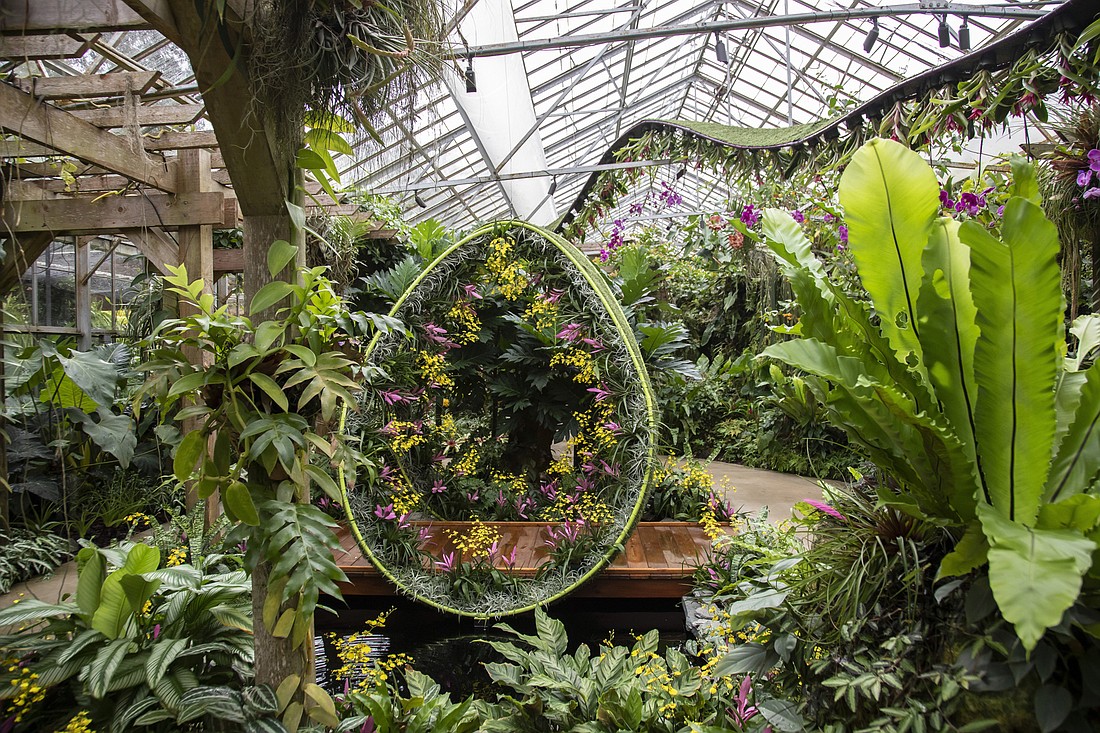- December 5, 2025
-
-
Loading

Loading

Angel Lara recently created a roller coaster out of orchids.
Well, that was the original idea, but it morphed into a DNA helix-shaped structure he calls an orchid ribbon instead. It’s currently on display at Marie Selby Botanical Gardens.
Planning elements like this for Selby’s 2018 Orchid Show: “Endless Forms” was no simple feat. But as a veteran exhibit designer (and greenhouse manager) at the gardens, Lara was up for the challenge.
The theme of the show is diversity of forms to teach visitors that there are way more orchid species in existence than they probably realize (that’s more than 25,000 species for those testing themselves). Those species also come in a variety of shapes and sizes that don’t always fit the image of grandma’s favorite floral centerpiece.
When he first started designing the exhibit, Lara says he was focusing too much on shape, and his vision became overly geometric. He scratched his original plans and instead landed on a DNA theme as a way to symbolize plant diversity.
“DNA is a core botanical tool,” Lara says. “What makes us different? Genetics.”
The 160-foot orchid ribbon literally and figuratively carries this design theme throughout the show. His original idea was to construct a double helix of orchids, but that was before he realized how hard it would be to put up just one. He’s glad he stuck with a single strand, whose curves loop across the ceiling of the greenhouse with plants that are often suspended at a 90-degree angle or completely upside-down.
Lara’s orchid ribbon was put together in 10-foot sections, each of which took six people to install. The PVC-pipe structure was put up first without flowers, and was then moved around using carabiners. Then, hardware cloth (a chicken wire-like material) was added to the back to secure the bromeliads and orchids that complete it. Each plant stands up straight thanks to a bamboo stake to which it’s zip-tied.
“Endless Forms” also features an orchid infinity loop that was first designed in the shape of a Möbius strip, aka a form — common in mathematics — with one continuous side created by twisting one end of a rectangular strip 180 degrees and joining it with the other end.
But that concept, much like that sentence, was too complicated. Instead, Lara decided to make it a loop in a shape that is having quite a moment on Pinterest (at least one millennial in your life probably has an infinity tattoo or necklace). Visitors looking to document their experience on social media should take a stroll under the large orchid infinity loop with their phone camera pointed up.
The DNA design also shows up in the education stations scattered throughout the greenhouse. These five podiums are for visitors to read material offering an in-depth look at subtopics of orchids, such as stems, flowers, roots, leaves, etc., and the function each serves in the orchid kingdom.
“This show focuses on us and what we do,” Lara says. “Conservation of orchids, collection of orchids, botanical inventory and all that jazz.”
Whether visitors are coming to see pretty orchids in a variety of aesthetically pleasing colors and designs or they are genuinely curious about the science behind these plants, Lara says this exhibit can pique any guest’s interest.
“It’s educational, but it still needs to be an orchid show,” he adds. “It still needs to have globs of color and just masses of orchids because that satisfies so many different demographics … the husband who doesn’t want to be here, the kid running around trying to find fish, all that.”
The show is also accessible in that not all of the orchids on display are rare specimens from Selby’s extensive collection (though they have plenty of those, some of which have been at the gardens for decades). Many orchids on display are plants anyone could buy at Home Depot or even Publix, Lara says.
But that’s not all. David Berry, associate director of academic affairs and special projects at The Ringling, also curated a complementary exhibit in the Payne Mansion’s Museum of Botany & the Arts that will showcase rare preserved orchid specimens and botanical prints. The goal of this aspect of the Orchid Show is to educate visitors about the various forms of botanical evidence tools used by plant researchers.
Rare botanical books from the Selby Gardens Research Library will also be released from the vault.
So, why should people care about an exhibit on the diversity of orchids?
“They’re more than a pretty family,” Lara says. “When people learn about what we have here, their eyes light up.”